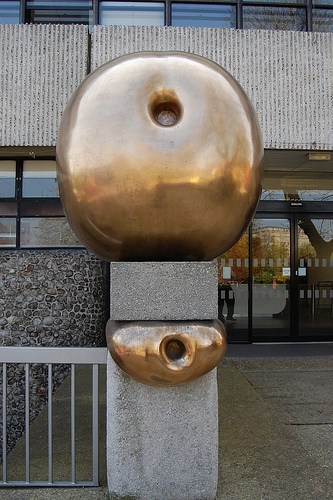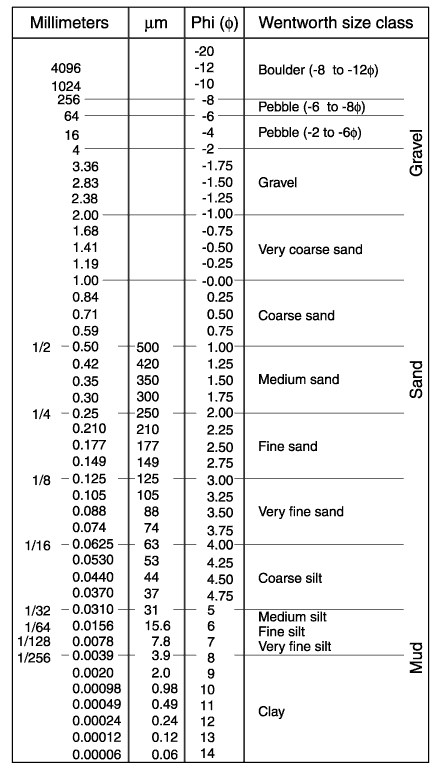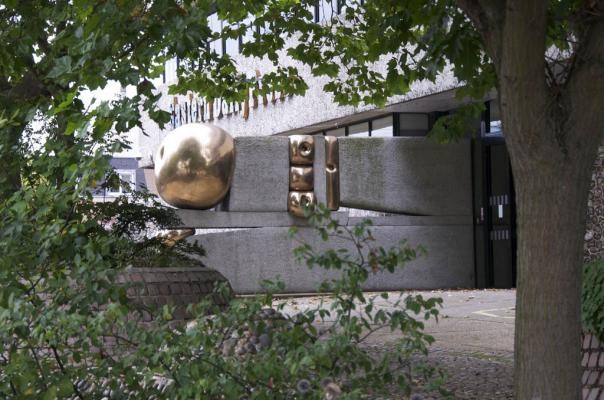
What Bernard Meadows created for the Prospect House entrance on Rouen Road was an uncompromising assembly of stone / concrete blocks and balls of dripping and dimpled metal.
Love it or loathe it, the piece - baldly called Public Sculpture - has proved an imposing presence on the city skyline, and the current overhaul of the newspaper building has brought the chance to celebrate a controversial Norwich-raised talent.
While some have found the bronze bits rather rude - and the words “belly buttons” are often mentioned - the sculptor was inspired by the Woolpack pub sign in Golden Ball Street.
Installed: 1970
(More information on the art further down. BUT first some earth lesson.)

Focus on aggregate used in boulder.
**Aggregate (sand, gravel, crushed stone, slag), is a broad category of coarse particulate material used in construction. Aggregates are the most mined materials in the world. Aggregates are a component of composite materials such as concrete and asphalt concrete; the aggregate serves as reinforcement to add strength to the overall composite material. Due to the relatively high hydraulic conductivity value as compared to most soils, aggregates are widely used in drainage applications such as foundation and French drains, septic drain fields, retaining wall drains, and road side edge drains. Aggregates are also used as base material under foundations, roads, and railroads. In other words, aggregates are used as a stable foundation or road/rail base with predictable, uniform properties (e.g. to help prevent differential settling under the road or building), or as a low-cost extender that binds with more expensive cement or asphalt to form concrete.
Sand: Sand is any material composed of loose, stony grains between 1/16 mm and 2 mm in diameter. Larger particles are categorized as gravel, smaller particles are categorized as silt or clay . Sands are usually created by the breakdown of rocks, and are transported by wind and water , before depositing to form soils, beaches, dunes , and underwater fans or deltas. Deposits of sand are often cemented together over time to form sandstones.

The most common sand-forming process is weathering , especially of granite . Granite consists of distinct crystals of quartz, feldspar , and other minerals . When exposed to water, some of these minerals (e.g., feldspar) decay chemically faster than others (especially quartz), allowing the granite to crumble into fragments. Sand formed by weathering is termed epiclastic.
Gravel: aggregate of more or less rounded rock fragments coarser than sand (i.e., more than 2 mm [0.08 inch] in diameter). Fragments in gravel range in size from pebbles (4–64 mm [0.16–2.52 inches] in diameter), through cobbles (64–256 mm [2.52–10.08 inches]), to boulders (larger than 256 mm).

Gravel is composed of various kinds of rock, the most common constituent being the mineral quartz. Deposits of gravel are formed as a result of the weathering of rocks and the erosive and concentrating action of rivers and waves. Sometimes gravel becomes consolidated into the sedimentary rock called conglomerate. Gravel is used extensively in building roads and in making concrete. For road building it is crushed into angular particles of uniform size. One or more layers of gravel underlie the road surface. A small percentage of clay must be present to act as a binder when gravel is used in macadam for road surfaces. When used as a coarse aggregate for concrete, gravel must be clean and free from clay and organic matter. Commercially, it is classified according to the size of the particles. In areas where natural deposits are inadequate, gravel is produced by quarrying and crushing durable rocks, such as sandstone, limestone, or basalt.
Slag: by-product formed in smelting, welding, and other metallurgical and combustion processes from impurities in the metals or ores being treated. Slag consists mostly of mixed oxides of elements such as silicon, sulfur, phosphorus, and aluminum; ash; and products formed in their reactions with furnace linings and fluxing substances such as limestone. Slag floats on the surface of the molten metal, protecting it from oxidation by the atmosphere and keeping it clean. Slag forms a coarse aggregate used in certain concretes.
Aggregate that is used in construction as concrete vary in size. And here is a chart on what sizes that are used. The scale shows you the Wentworth size class, Mud (Silt), Sand and gravel.


To log this cache.
To get to log this cache you will have to visit and answer the questions which are related to the coordinates given the earthcache.
When answers are collected, send them to CO for verification.
As I own about 50 earthcaches there are MANY mails/messages to answer back on, and I will not always be able to answer right-back, BUT I READ ALL SENT ANSWERS AND LOGS, so if anything is not correct or need an upgrade, you will indeed hear back from me.
Thanks for your understanding, and for picking one of my caches.
You can log immediately answers are sent CO. If there are any questions about your answers CO will contact you.
Logs without answers to CO or with pending questions from CO will be deleted without any further notice.
Please do not include pictures in your log that may answer the questions.

Questions
1. Answer the questions under by visiting the Coordinates.
A.What is Aggregate? And why is it used in making concrete?
B. What are the colors of the aggregates / particles in the boulder at gz. (Answer can be found at GZ)
C. What is the crushed grade of the aggregate used in this concrete boulder? Measure it, and tell what size it is, and what Wentworth class size do you than have. (Use the chart up in the text) (Answer can be found at GZ)
D. Can you see any wear on the boulder? And if so, what? (Answer can be found at GZ)
2. Take a photo of yourself, the group or your GPS when logging the cache.
Without revealing any answers!
(It’s voluntary to post a photo in your online log)
Golden Ball

Jutting out on a concrete plinth at the top of the flight of steps leading to the main entrance of Prospect House Public Sculpture dominates the junction of Rouen Road with Cattle Market and Golden Ball Streets. The concrete base supports a small golden ball squashed under another strip of concrete which supports the largest of the series with a further three set further back between two concrete blocks.
Prospect House was completed in 1970 to house the offices and printing presses of Eastern Counties Newspapers. The architects - Yates Cook and Derbyshire - adapted the idiom of the new brutalism in their treatment of the concrete panels set over the steel frame. Bernard Meadows had begun his career as one of the sculptors who, according to Sir Herbert Read in 1952, had developed the ?geometry of fear?, discussed under the entry for Bernard Reynolds? Triple Mycomorph of 1953 see under Ipswich, Christchurch Mansion. Meadows had continued in this vein during the early 1960s before developing a new idiom, again under the influence of Henry Moore, most notably of sculptures like the Locking Pieces of 1963-64, now displayed at Vauxhall Bridge Gardens. Beginning with his Pointing Figure with Child of 1966 (BM 105) now in Churchill College, Cambridge and in two versions of Help (BM 102 and 103) both of 1966, one of which is in City of Bristol Art Gallery, Meadows turned Moore?s forms into enigmatic dimpled balls which are squashed between larger shapes. Public Sculpture combines this element of Help with a large Golden Ball, apparently liberated from the weight of the rest of the structure in response to the adjoining 'Golden Ball Street' and the large gilded sign of the Woolpack public house, then just around the corner.
Bernard Meadows, who died in 2005 in his 90th year, was one of the most important British sculptors of the 20th century. Public Sculpture is his largest and greatest work.
Meadows got his big break at 21 when taken to meet Henry Moore. The next day he received a postcard inviting him to help out in the great man's studio during art school holidays.
For four years “the boy” worked up to 20-hour shifts in the strict Moore regime. Conditions were Spartan, pay was non-existent - and the experience set him up for life.
After war service with the RAF, Meadows taught at London's Royal College of Art, being Professor of Sculpture 1960-1980. His elm figure for the 1951 Festival of Britain went to the Tate. A year later he went to the Venice Biennale.
He exhibited from New York to Tokyo and produced a stream of public and private art in Britain and beyond. His edgy pieces, often based on animals and seemingly carved from shrapnel, could imply Cold War menace.
But teaching commitments took him away from his own work. He returned to assist Moore from 1977, and continued to help his mentor's estate.
